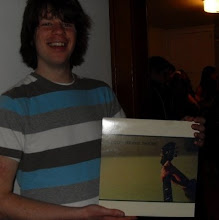
"Hey, we should trade mix CDs sometime!"
"I'm going to make you a mix. You'll love it."
"So I'm making a mix CD for this cool girl in my history class..."
To the music lover, there are precious few forms of communication more personal and revealing than that of the mix CD. You spend hours, agonizing over which Beach Boys song is really the right one, if including Bob Dylan's "I Want You" will completely blow the cover off your agenda, or if this ten-minute long Detroit techno single you've been digging lately is going to be up their alley ("It's up my alley," you'll think, "and everything I like is awesome.") Maybe you're trying to express yourself, maybe you're just trying to put together your favorite songs in one place, but there's almost always a clear motivation behind pushing the "burn" button
I want to first note my use the term "CD"--I use it because it's been the most prevalent form of mix trading... well, I'd say "of my generation," but that's a bit too sweeping. We'll say that most mix swaps I've taken part in have been on shiny compact disc format, the kind you can buy in bulk at Best Buy. I've gone through more of these than I can count since having access to a CD burner, each with some supposedly clever title scrawled in Sharpie across the front (the last one I made, for a buddy of mine, was called "19 #1 Smash Hit Singles from the 1970's." It was a red herring.)
But historically, it was cassette tapes that kick-started this homespun artform. The book Mix Tape: The Art of Cassette Culture, written by indie rock godhead/Sonic Youth front man Thurston Moore, notes:
Durable, inexpensive, and portable, the new format was an instant success. By the 1970s, we were voraciously recording music onto blank cassettes. It allowed us to listen to, and, in effect, curate music in a new way. Privately. Mix tapes let us become our own DJs, creating mixes for friends, lovers, and family, for parties and road trips.And though this kind of freedom of listening carried over into burnable compact discs, then further extrapolated with the advent of Internet file sharing, cassette tapes are not something of ancient history. Pitchfork recently published this piece on the prevalence of cassette tapes among the indie rock contingent, as bands such as The Dirty Projectors released their last album on cassette as well as traditional 21st century formats.
This is the part of the post where I considered mapping out my "rules" for making a mix CD / tape, until I realized what a fruitless venture it would be. First, I don't necessarily have my own rules; inspiration hits and I work from there. Second, mix-making is a labor of love; following a set of rules inherently contradicts the personal nature behind the best mixes. Sure, like any thing that can be considered an art form, there's an element of craft that can't be ignored, but ultimately it's your expression--go nuts and do what you want.
That said, I did find this WikiHow article to closely mirror my own thought process when making a mix. Except for this part:
Group slower or softer songs together and then gradually build up momentum to more upbeat songs. A fast/heavy song might not go well after a soft, acoustic one.To be perfectly blunt: that rule is bullshit.
-WD
P.S., I can't resist embedding a clip of one of my favorite scenes from the movie High Fidelity (caution before pushing play, though, if you're in an area intolerant of vulgarity):


No comments:
Post a Comment
SAY SOMETHING!